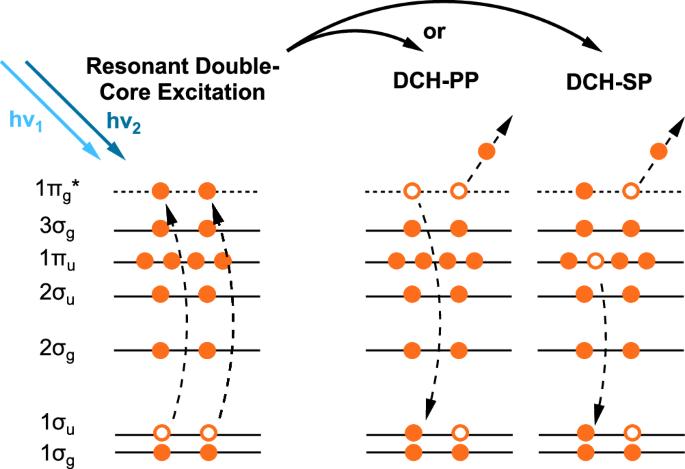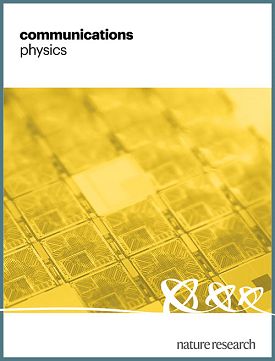观测强 X 射线脉冲驱动的分子共振双核激发
IF 5.4
1区 物理与天体物理
Q1 PHYSICS, MULTIDISCIPLINARY
引用次数: 0
摘要
X 射线自由电子激光器(XFEL)产生的超短和高强度 X 射线脉冲使我们能够对物质的原子级结构和动力学进行独特的实验,并允许在飞秒和阿秒级进行时间分辨研究。要充分利用它们,最重要的是全面了解在这种极端 X 射线强度下可能发生的复杂非线性相互作用。在这里,我们报告了对 N2 中共振双核激发方案的实验观察,在该方案中,两个 1σ 核级电子通过单个几皮秒宽带 XFEL 脉冲共振促进到未被占用的 $$1{\pi }_{g}^{* }$$ 分子轨道。这些中性双位双核空穴态的产生通过其特征衰变通道得到了证明,其观测结果与高水平理论计算结果十分吻合。这种多核激发方案得益于高相互作用截面以及共振 X 射线相互作用的状态和位点选择性,应该可以在 XFEL 照射的分子中普遍应用,并为化学分析和监测超快动态过程提供了有趣的机会。XFEL 可以在分子中典型核孔寿命的 fs 时间尺度内驱动多核电离/激发过程。本文报告了单个 XFEL 脉冲驱动的共振双核激发机制的实验证据,该机制在氮分子中产生了中性双位双核空穴态。本文章由计算机程序翻译,如有差异,请以英文原文为准。

Observation of molecular resonant double-core excitation driven by intense X-ray pulses
The ultrashort and intense pulses of X-rays produced at X-ray free electron lasers (XFELs) have enabled unique experiments on the atomic level structure and dynamics of matter, with time-resolved studies permitted in the femto- and attosecond regimes. To fully exploit them, it is paramount to obtain a comprehensive understanding of the complex nonlinear interactions that can occur at such extreme X-ray intensities. Herein, we report on the experimental observation of a resonant double-core excitation scheme in N2, where two 1σ core-level electrons are resonantly promoted to unoccupied $$1{\pi }_{g}^{* }$$ molecular orbitals by a single few-femtosecond broad-bandwidth XFEL pulse. The production of these neutral two-site double core hole states is evidenced through their characteristic decay channels, which are observed in good agreement with high-level theoretical calculations. Such multi-core excitation schemes, benefiting from the high interaction cross sections and state- and site-selective nature of resonant X-ray interactions, should be generally accessible in XFEL irradiated molecules, and provide interesting opportunities for chemical analysis and for monitoring ultrafast dynamic processes. XFELs can drive multicore-ionization/excitation processes in the fs timescale of typical core-hole lifetimes in molecules. This paper reports experimental evidence of a single XFEL-pulse-driven resonant double-core excitation mechanism, producing a neutral two-site double-core-hole state in the nitrogen molecule.
求助全文
通过发布文献求助,成功后即可免费获取论文全文。
去求助
来源期刊

Communications Physics
Physics and Astronomy-General Physics and Astronomy
CiteScore
8.40
自引率
3.60%
发文量
276
审稿时长
13 weeks
期刊介绍:
Communications Physics is an open access journal from Nature Research publishing high-quality research, reviews and commentary in all areas of the physical sciences. Research papers published by the journal represent significant advances bringing new insight to a specialized area of research in physics. We also aim to provide a community forum for issues of importance to all physicists, regardless of sub-discipline.
The scope of the journal covers all areas of experimental, applied, fundamental, and interdisciplinary physical sciences. Primary research published in Communications Physics includes novel experimental results, new techniques or computational methods that may influence the work of others in the sub-discipline. We also consider submissions from adjacent research fields where the central advance of the study is of interest to physicists, for example material sciences, physical chemistry and technologies.
 求助内容:
求助内容: 应助结果提醒方式:
应助结果提醒方式:


